Study on the Vortex in a Pump Sump and Its Influence on the Pump Unit
Abstract
:1. Introduction
2. Numerical Calculation
2.1. Numerical Model
2.1.1. Reynolds-Averaged Navier–Stokes Equations
2.1.2. Turbulence Model
2.1.3. Multiphase Flow Model
2.2. Establishment of Computational Model and Mesh Generation
2.3. Boundary Setup
2.4. Test Introduction
3. Results Discussion
3.1. Reliability Verification of the Numerical Simulation Results
3.2. Spatial Variation of Pressure Distribution in the Vortex Area
3.3. Instantaneous Change of Vortex Core Pressure
- (1)
- Temporal change characteristics of pressure in a vortex core
- (2)
- Spatial variation characteristics of the pressure in the vortex core
- (3)
- Pressure variation with vortex core radius in the vortex core
3.4. Pressure Gradient Characteristics in the Vortex Zone
3.5. Influence of the FAV on Pump Units
4. Discussion
5. Conclusions
- The spatiotemporal evolution characteristics of pressure in the process of the FAV evolution were analyzed. The pressure distributions in the vortex area show that the FAV was located at the low-pressure area, and double vortices appeared in the inception stage. In the early development stage, the two low-pressure areas gradually merged and intersected, which means that the two vortices had merged and the low-pressure areas continued to expand. In the later development stage (t = 1.63 s), the double low-pressure areas in the vortex area merged into a single low-pressure area.
- The changing trend of the pressure in the core area of the FAV first slowly decreased and then increased rapidly, which can also indicate that the time of the FAV formation and development was longer than that of the collapse and disappearance. The pressure in the vortex core gradually increased with the radius of the vortex core. The pressure in the core kept decreasing and increasing with time, and was the lowest in the continuance stage. The evolution of the FAV was accompanied by a change of pressure gradient. The pressure gradient in the non-central area of the vortex core was the largest, while that in the central area of the vortex core was extremely small.
- The harm of the FAV to the unit is mainly that it can reduce pump operation efficiency. When there is no vortex, the pressure of the impeller inlet changes stably with time. But that fluctuates unsteadily over time when the FAV exists at the impeller. Due to the vortex core having a negative pressure area, when the negative pressure of the vortex tube is around the vaporization pressure level in the continuance stage, it can cause a local cavitation at the impeller.
Author Contributions
Funding
Institutional Review Board Statement
Informed Consent Statement
Data Availability Statement
Conflicts of Interest
References
- Anup, K.C.; Young, H.L.; Bhola, T. CFD study on prediction of vortex shedding in draft tube of francis turbine and vortex control techniques. Renew. Energy 2016, 86, 1406–1421. [Google Scholar]
- Kan, K.; Yang, Z.; Lyu, P.; Zheng, Y.; Shen, L. Numerical study of turbulent flow past a rotating axial-flow pump based on a level-set immersed boundary method. Renew. Energy 2021, 168, 960–971. [Google Scholar] [CrossRef]
- Yu, H.D.; Wang, Y.Q. Liutex-based vortex dynamics: A preliminary study. J. Hydrodyn. 2020, 32, 1217–1220. [Google Scholar] [CrossRef]
- Liu, C.; Gao, Y.S.; Dong, X.R.; Wang, Y.Q.; Liu, J.M.; Zhang, Y.N.; Cai, X.S.; Gui, N. Third generation of vortex identification methods: Omega and Liutex/Rortex based systems. J. Hydrodyn. 2019, 31, 205–223. [Google Scholar] [CrossRef]
- Zhao, M.S.; Zhao, W.W.; Wan, D.C. Numerical simulations of propeller cavitation flows based on Open Foam. J. Hydrodyn. 2020, 32, 1071–1079. [Google Scholar] [CrossRef]
- Norizan, R.E.; Harun, Z. Enhancement of vorticity reduction by floor splitter in pump sump to improve pump efficiency. Sustain. Energy Technol. Assess. 2018, 26, 28–37. [Google Scholar] [CrossRef]
- Ansar, M.; Tatsuaki, N.; George, C. Numerical simulations of inviscid three-dimensional flows at single- and dual-pump intakes. J. Hydraul. Res. 2002, 40, 461–470. [Google Scholar] [CrossRef]
- Dong, X.; Dong, G.; Liu, C. Study on vorticity structures in late flow transition. Phys. Fluids 2018, 30, 104–108. [Google Scholar] [CrossRef] [Green Version]
- Nahale, S.; Reza, M.; Michel, J.C. Investigation of rotating vortex rope formation during load variation in a francis turbine draft tube. Renew. Energy 2020, 151, 238–254. [Google Scholar]
- Constantinescu, G.S.; Patel, V.C. Numerical model for simulation of pump-intake flow and vortices. J. Hydraul. Eng. 2008, 24, 123–134. [Google Scholar] [CrossRef]
- Monshizadeh, M.; Tahershamsi, A.; Rahimzadeh, D. Comparison between hydraulic and structural based anti-vortex methods at intakes. Eur. Phys. J. Plus 2017, 132, 291–302. [Google Scholar] [CrossRef]
- Rajendran, V.P.; Patel, V.C. Measurement of vortices in model pump-intake bay by PIV. J. Hydraul. Eng. 2000, 126, 322–334. [Google Scholar] [CrossRef]
- Duinmeijera, S.P.; Moreno, R.A.; Antonio, M. A simple measuring set-up for the experimental determination of the dynamics of a large particle in the 3D velocity field around a free surface vortex. Flow Meas. Instrum. 2019, 65, 52–64. [Google Scholar] [CrossRef]
- Amiri, S.M.; Zarrati, A.R.; Roshan, R. Surface vortex prevention at power intakes by horizontal plates. Proc. Inst. Civ. Eng.-Water Manag. 2011, 164, 193–200. [Google Scholar] [CrossRef]
- Liu, C.; Liang, H.; Jin, Y. PIV Measurements of intake flow field in axial-flow pump. Trans. Chin. Soc. Agric. Mach. 2015, 46, 33–41. [Google Scholar]
- Xu, J. Numerical Simulation and V3V Measurements on Inlet Rotation Flow of Vertical Axial-Flow Pump; Yangzhou University: Yangzhou, China, 2016. [Google Scholar]
- Gupta, R.; Kaulaskar, M.D.; Kumar, V. Studies on the understanding mechanism of air core and vortex formation in a hydro-cyclone. Chem. Eng. J. 2008, 144, 153–166. [Google Scholar] [CrossRef]
- Hite, J.E.; Mih, W.C. Velocity of air-core vortices at hydraulic intakes. J. Hydraul. Eng. ASCE 1994, 120, 284–297. [Google Scholar] [CrossRef]
- Zhu, B.; Chen, H. Analysis of the staggered and fixed cavitation phenomenon observed in centrifugal pumps employing a gap drainage impeller. J. Fluids Eng. 2017, 139, 031301. [Google Scholar] [CrossRef]
- Zhang, D.; Shi, W.; Pan, D.; Dubuisson, M. Numerical andexperimental investigation of tip leakage vortex cavitation patterns and mechanisms in an axial flow pump. Comput. Fluids 2015, 112, 61–71. [Google Scholar] [CrossRef]
- Kim, J.; Song, S.J. Measurement of temperature effects on cavitation in a turbopump inducer. J. Fluids Eng. 2016, 138, 011304. [Google Scholar] [CrossRef]
- Dutta, R.; Xing, T. Five-equation and robust three-equation method for solution verification of large eddy simulations. J. Hydrodyn. 2018, 30, 23–33. [Google Scholar] [CrossRef]
- Chen, H.X. Research on turbulent flow within the vortex pump. J. Hydrodyn. 2004, 16, 701–707. [Google Scholar]
- Jong, W.C.; Young, D.C.; Chang, G.K. Flow uniformity in a multi-intake pump sump model. J. Mech. Sci. Technol. 2010, 24, 1389–1400. [Google Scholar]
- Menter, F.R. Two-equation eddy-viscosity turbulence models for engineering applications. AIAA J. 1994, 32, 1598–1605. [Google Scholar] [CrossRef] [Green Version]
- Smirnov, P.E.; Menter, F.R. Sensitization of the SST turbulence model to rotation and curvature by applying the Spalart–Shur correction term. J. Turbomach. 2009, 131, 041010. [Google Scholar] [CrossRef]
- Yamade, Y.; Kato, C.; Nagahara, T.; Matsui, J. Suction vortices in a pump sump-their origin, formation, and dynamics. J. Fluids Eng. ASME 2020, 142, 323–331. [Google Scholar] [CrossRef]
- Huang, B.; Young, Y.L.; Wang, G.; Shyy, W. Combined experimental and computational investigation of unsteady structure of sheet/cloud cavitation. J. Fluids Eng. 2013, 135, 071301. [Google Scholar] [CrossRef]
- Škerlavaj, A.; Škerget, L.; Ravnik, J. Predicting free-surface vortices with single-phase simulations. Eng. Appl. Comput. Fluid Mech. 2014, 8, 193–210. [Google Scholar] [CrossRef] [Green Version]
- Song, X.J.; Yao, R.; Chao, L.; Wang, Z.W. Study of the formation and dynamic characteristics of the vortex in the pump sump by CFD and experiment. J. Hydrodyn. 2021, 33, 93–103. [Google Scholar] [CrossRef]
- Song, X.J.; Liu, C. Experimental study of the floor-attached vortices in pump sump using V3V. Renew. Energy 2021, 164, 752–766. [Google Scholar] [CrossRef]
- Song, X.J.; Liu, C. Experimental investigation of pressure pulsation induced by the floor-attached vortex in an axial flow pump. Adv. Mech. Eng. 2019, 11, 1–13. [Google Scholar] [CrossRef] [Green Version]
- Song, X.J.; Liu, C. Experimental investigation of floor-attached vortex effects on the pressure pulsation at the bottom of the axial flow pump sump. Renew. Energy 2020, 145, 2327–2336. [Google Scholar] [CrossRef]
- Long, N.I.; Shin, B.R.; Douw, D.H. Study on surface vortices in pump sump. J. Fluid Mach. 2012, 15, 60–66. [Google Scholar] [CrossRef]
- Pennings, P.; Westerweel, J.; Terwisga, T. Flow field measurement around vortex cavitation. Exp. Fluids 2015, 56, 206. [Google Scholar] [CrossRef] [Green Version]
- Amini, A.; Reclari, M.; Sano, T.; Iino, M.; Farhat, M. Suppressing tip vortex cavitation by winglets. Exp. Fluids 2019, 60, 159. [Google Scholar] [CrossRef]
- Sarkardeh, H.; Zarrati, A.R.; Roshan, R. Effect of intake head wall and trash rack on vortices. J. Hydraul. Res. 2010, 48, 108–112. [Google Scholar] [CrossRef] [Green Version]



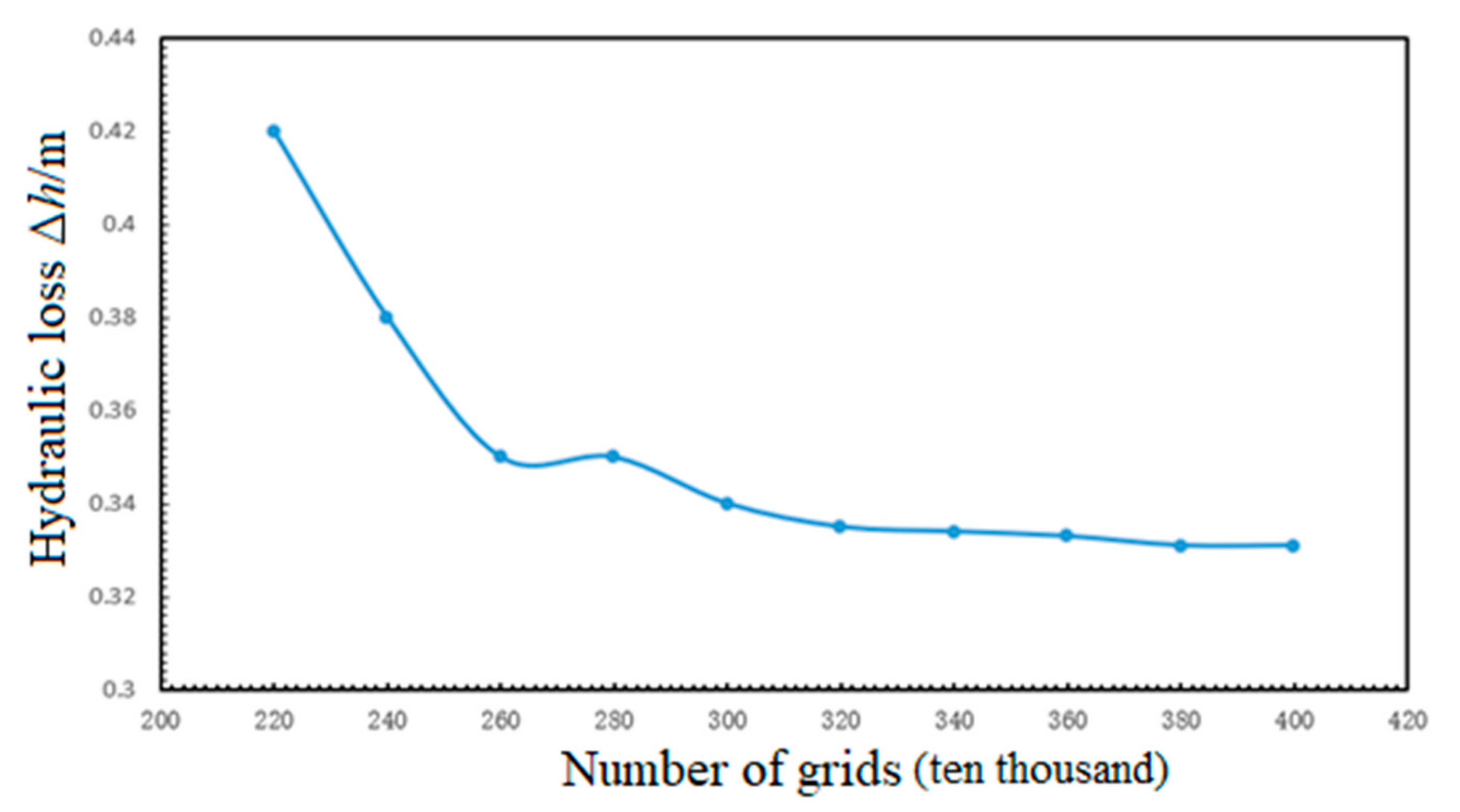

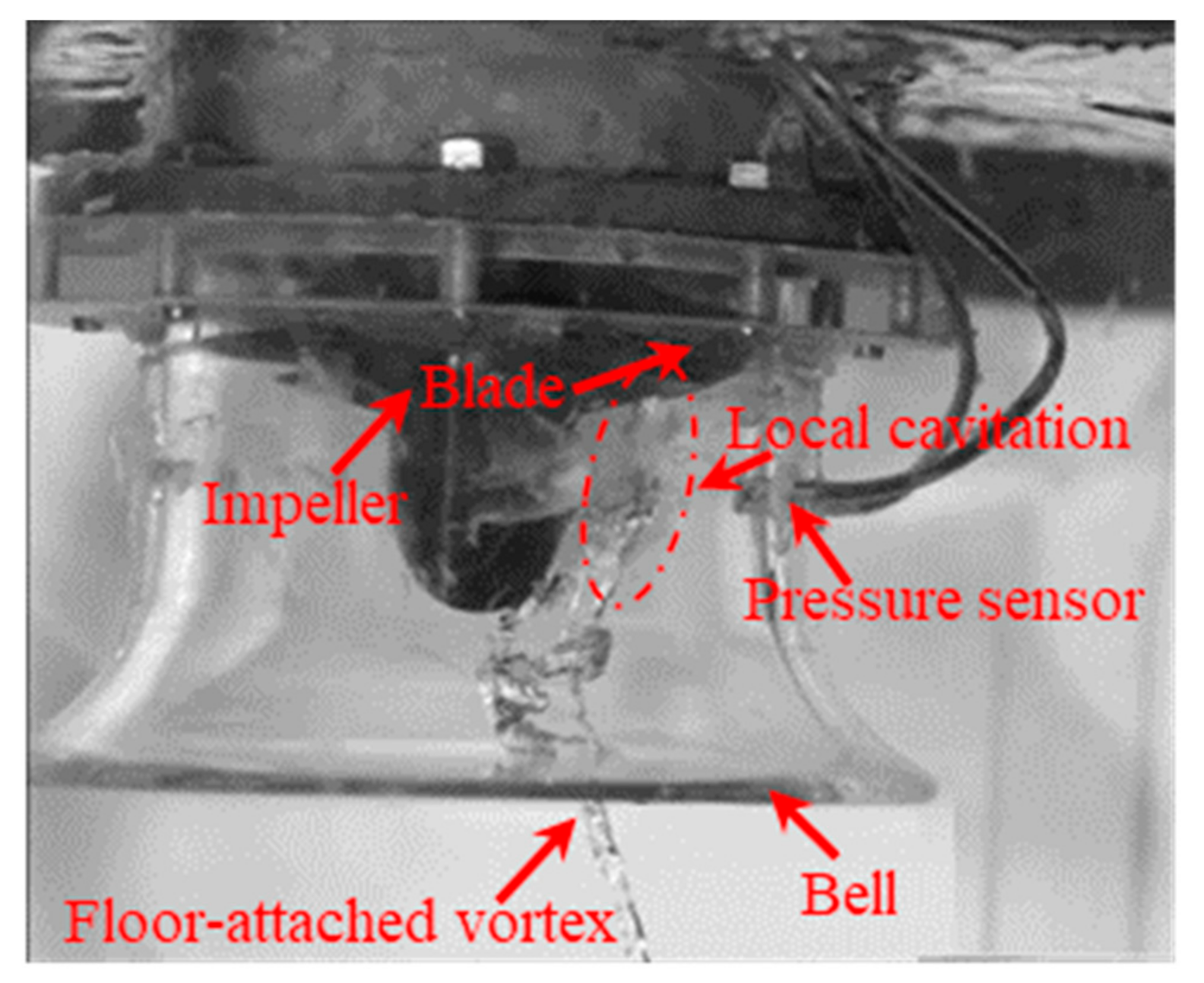

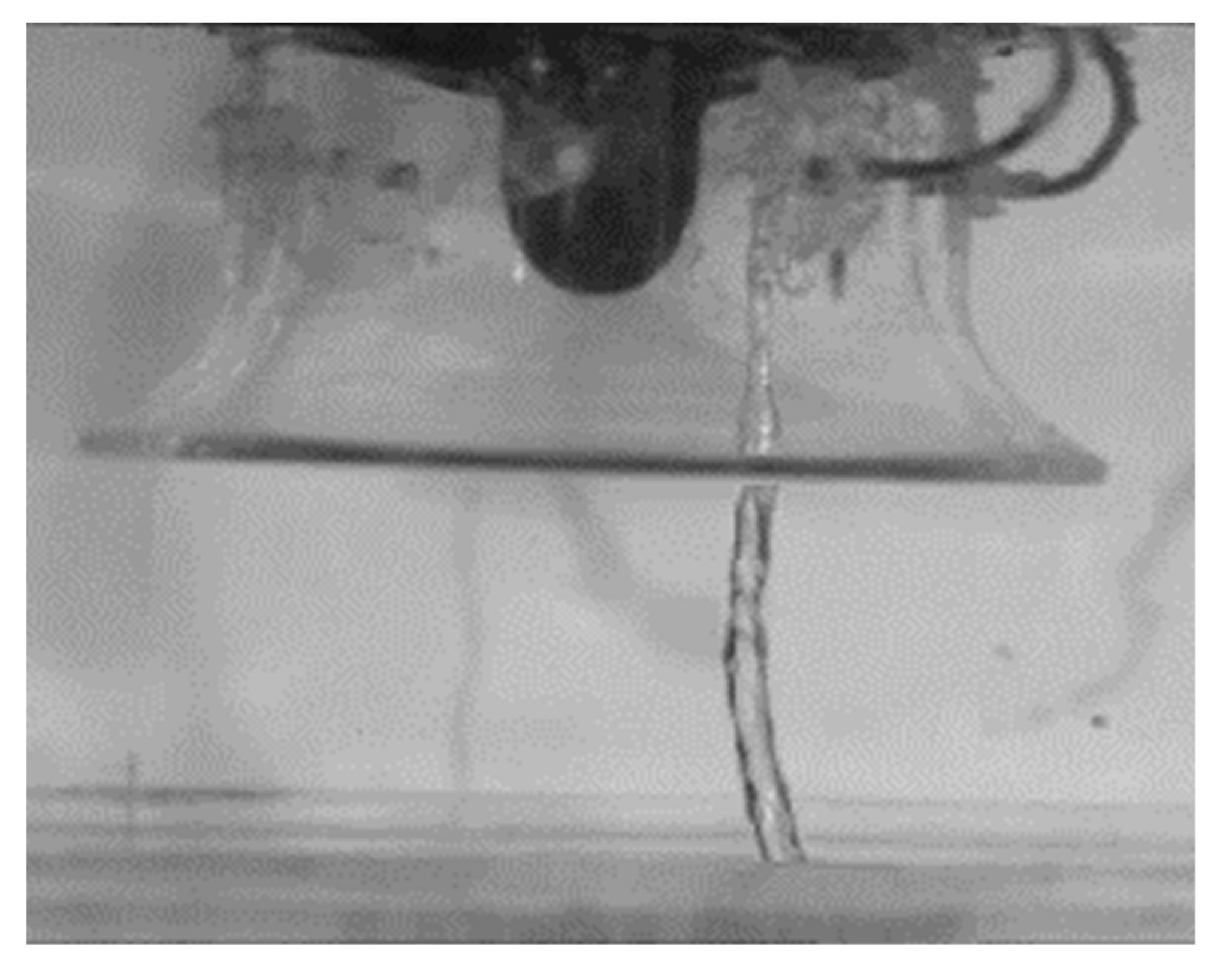



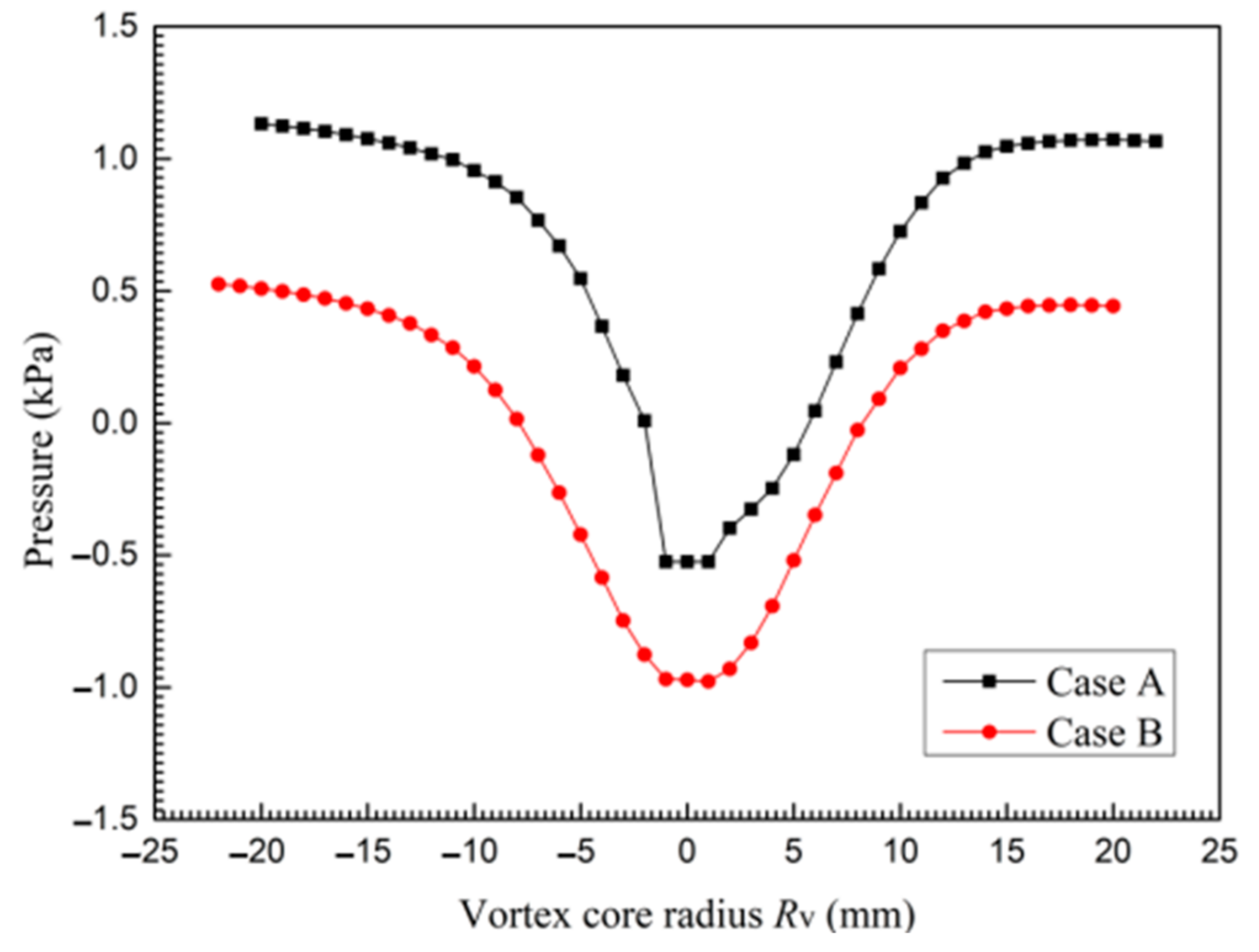

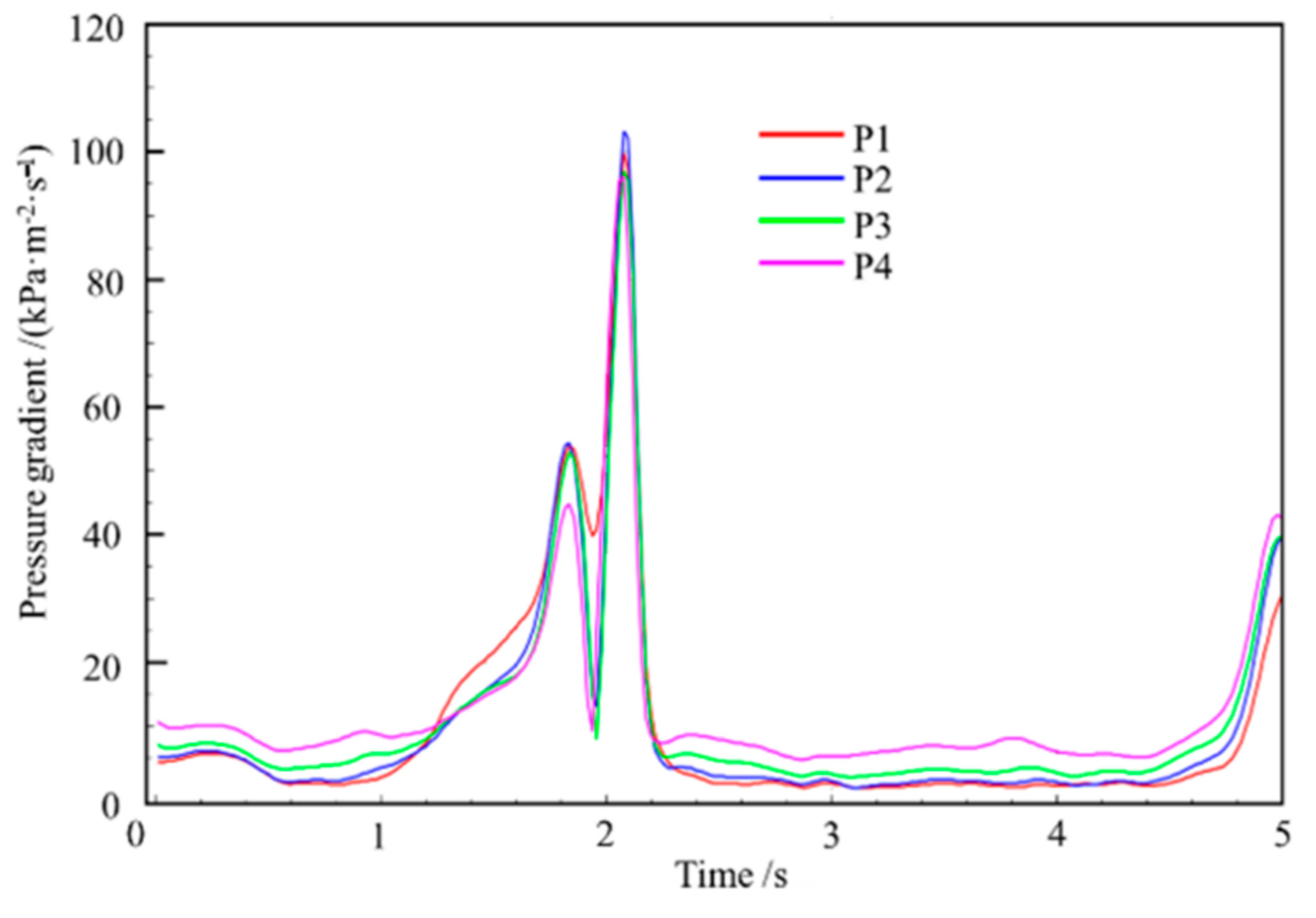


Publisher’s Note: MDPI stays neutral with regard to jurisdictional claims in published maps and institutional affiliations. |
© 2022 by the authors. Licensee MDPI, Basel, Switzerland. This article is an open access article distributed under the terms and conditions of the Creative Commons Attribution (CC BY) license (https://creativecommons.org/licenses/by/4.0/).
Share and Cite
Song, X.; Liu, C.; Wang, Z. Study on the Vortex in a Pump Sump and Its Influence on the Pump Unit. J. Mar. Sci. Eng. 2022, 10, 103. https://doi.org/10.3390/jmse10010103
Song X, Liu C, Wang Z. Study on the Vortex in a Pump Sump and Its Influence on the Pump Unit. Journal of Marine Science and Engineering. 2022; 10(1):103. https://doi.org/10.3390/jmse10010103
Chicago/Turabian StyleSong, Xijie, Chao Liu, and Zhengwei Wang. 2022. "Study on the Vortex in a Pump Sump and Its Influence on the Pump Unit" Journal of Marine Science and Engineering 10, no. 1: 103. https://doi.org/10.3390/jmse10010103



